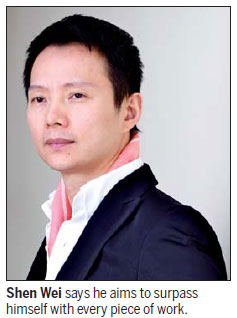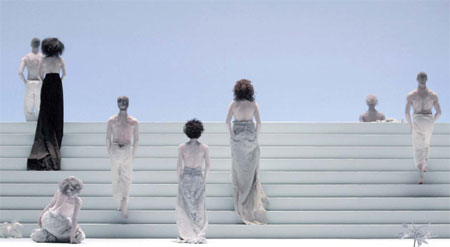Traditional modernist
Updated: 2012-11-16 11:26
By Sun Yuanqing (China Daily)
|
|||||||||||
|
Shen Wei's Near the Terrace (pictured) and Rite of Spring will be presented in Beijing on Nov 19 and Nov 20. Provided to China Daily |

Shen Wei has found success as a choreographer by embracing both his Chinese roots and Western ideas
The one-hour talk extended to one and a half hours and even then, 30 minutes after it ended, members of the audience and media crowded outside the dressing room of Shen Wei, hoping for more. The scene, at a recent event in Beijing, was testimony to the success of Shen, who is among China's most acclaimed choreographers and who worked on the opening ceremony of the Beijing Olympics.
Deeply rooted in both his native Chinese culture and Western classical arts, Shen's dance routines have stunned audiences with a combination of abstract expressionism and Western modernism. Now he is encouraging the same boldness and innovation from his compatriots, at a time when there is confusion about how to revive traditional Chinese arts.
"There is no fixed rule in art," Shen says. "You are your own rule setter. Think about how Mei Lanfang transformed Peking opera in his time. Why not be daring as he was? People might not accept it at the moment, but as long as it's artistically good, it will last."
On Nov 19 and 20 Shen will present two of his dance works, Rite of Spring and Near the Terrace, at the National Theater Dance Festival.
It will be the first time Shen has showcased his work on the Chinese mainland since the opening ceremony of the 2008 Beijing Olympics, for which he choreographed the breathtakingly beautiful routine Scroll.
Before the performances, Shen gave three public talks in Beijing explaining his work and artistic path.
"Some (of the pieces) you might find hard to accept, some dull, some you might relate to. And this is not a problem. I fell asleep after 10 minutes during my first visit to a Western opera. I woke up at the second set and was completely fascinated, and insisted on coming back when the third set ended," he says.
"It's fine if you don't understand. Take your time and learn. Once you get it, it becomes part of you and makes you a richer person."
This might also be a perfect illustration of Shen's own artistic evolution, which involved a love of various forms of art.
Born into an artistic family in Central China's Hunan province in 1968, Shen grew up practicing Chinese traditional painting and calligraphy. When he was 9 he started training as a Chinese opera performer, practicing singing, dancing and performing.
In 1984 he joined the Hunan State Xian Opera Company as a leading martial arts actor.
"The 11 years of Chinese opera training gave me a profound understanding of my own culture," he recalls.
As China opened up in the early 1980s and more Western culture was introduced, Shen began to learn Western classical fine arts.
"This was a transition in my learning from Chinese traditional arts to Western classical arts. It opened me up to Western aesthetics, as well as the development of their culture and history."
In 1984 Shen had a modern-art epiphany when he saw the painting Nude Descending a Staircase by the French artist Marcel Duchamp.
"I found the high abstraction to be very interesting. I have since been fascinated by modern art and its development, which is very different from the rote learning of Chinese traditional arts. I realized that I could actually be a creator rather than a mere imitator of tradition."
The thought of being able to "create" led him further into modern art and culture.
However, Shen, who reckons he is now more fluent in English than in his native Chinese, failed to get a place at the Central Academy of Fine Arts for his poor English grades. Instead, his painting earned him a place at China's first modern dance school, the Guangzhou Modern Dance Academy, because of its advanced modernist ideas.
There Shen was taught by masters including Ross Parks and David Hochoy through a school program in association with the American Dance Festival and the Asian Cultural Council.
In 1991 he became one of the founding members of China's first modern dance company, and was later awarded first prize in both choreography and performance in the National Modern Dance Competition.
Shen moved to New York in 1995 on a scholarship from the Nikolais/Louis Dance Lab.
"I felt like nothing when I first came to New York. I didn't understand anything, and that is a huge contrast to what it was like for me in China. The thing was I didn't know enough to understand."
For the next five years he immersed himself in the world of Western art films, opera and classical music.
"I kept learning, creating and eventually found a new life."
Shen's breakthrough came in 2000 when two pieces of his work, Folding commissioned by Guangzhou Dance Company and Near the Terrace found success. Invitations soon flooded in, and later that year he founded his own company Shen Wei Dance Arts.
"My first five years in New York were very hard, like all the other artists in the city. I had no intention of getting famous, let alone starting a company. All I wanted was to live the life of a New York artist, learning and seeing performances."
The company has toured in more than 30 countries and 130 cities, performing at festivals and venues including the Venice Biennale, Het Muziektheater and the Hong Kong New Vision Festival.
The company also enjoyed a five-year performance residency at the John F. Kennedy Center for the Performing Arts in Washington.
For Shen, nothing comes easy. He stays as earnest as ever.
"Whatever piece I'm doing, it's always my hardest one, because I want to surpass myself. You can see this in the difference between Second Visit to the Empress and Undivided Divided. I can't repeat myself if I want to maintain my creativity. Every time I create a new piece, I say to myself, 'It's not going to happen this time. It's going to be a disaster this time.'"
Of course it never has been. On the contrary, his devotion to his art and the uniqueness of his work have continued to impress and surprise audiences.
In his adaptation of the Chinese opera Second Visit to the Empress, Shen trained Western ballet dancers to move with chi (inner energy flow), presenting the essence of Chinese opera in a sketchy yet powerful way.
In his latest modernist piece, Undivided Divided, Shen invisibly employs Yi Ching, a classic Chinese text that includes cosmology and philosophy, in the layout of the dance.
The secret to how Shen merges a variety of artistic styles into his work is, according to the choreographer, love.
"I love Chinese opera so much. I practice long sleeves every day. I make the Western dancers practice tai chi because I know the value of doing so. I love it and I want to make it even better. But I also love modern dance for its creativity. It makes every day new.
"I still read Tang poetry and Song lyrics on the metro even in New York. It doesn't necessarily mean I have to feature them in my work. But it becomes part of me, my aesthetics and my vision, which will be traced in my work in one way or another."
sunyuanqing@chinadaily.com.cn
(China Daily 11/16/2012 page29)
Today's Top News
Rescuers race against time for quake victims
Telecom workers restore links
Coal mine blast kills 18 in Jilin
Intl scholarship puts China on the map
More bird flu patients discharged
Gold loses sheen, but still a safe bet
US 'turns blind eye to human rights'
Telecom workers restore links
Hot Topics
Lunar probe , China growth forecasts, Emission rules get tougher, China seen through 'colored lens', International board,
Editor's Picks

|

|

|

|

|

|






